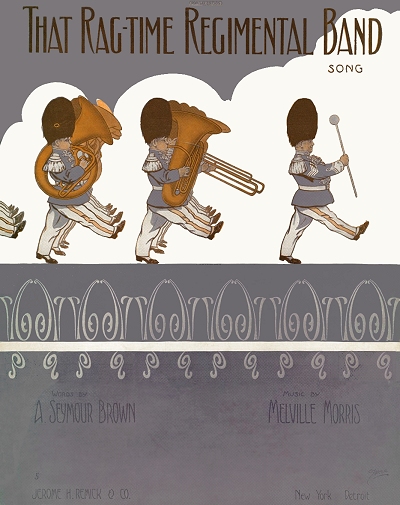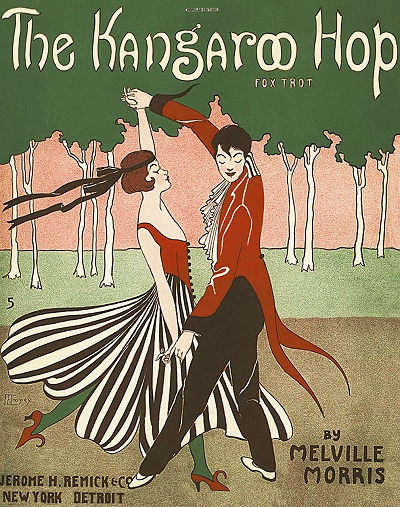|
Melville Morris (October 5, 1888 to February 10, 1987) | |
 Compositions Compositions | |
|
1911
That Ragtime Regimental Band [1]1914
Kewpie Doll [2]1915
On the Bay of Old BombayKangaroo Hop 1916
Kangaroo Hop (Song) [3]Tiddle-De-Winks 1917
Cute and Pretty: Fox TrotWho's Who 1919
Down Around the River at the Dixie Jubilee [4] |
1922
The Big Fun Show: RevueFolly Town: Revue Maids of America: Revue 1923
Americans Abroad: RevueThe Peek Inn Revue Pepper Box: Revue Bubble, Bubble: Revue 1924
Peek-A-Boo: Revue
1. w/A. Seymour Brown
2. w/Edward Madden & Albert Gumble 3. w/Gus Kahn 4. w/Jack Yellen |
 Selected Rollography Selected Rollography | |
|
1913
Mammy Jinny's JubileeSomebody Loves You Ragtime Regimental Band |
Matrix
[Rythmodik ?][Rythmodik ?] [Rythmodik ?] |
Little is known about the early life of Melville Morris, but what details were found are presented here, some for the first time. He was born in New York to an English immigrant of German descent, Gustave Morris, and his wife Minnie Greenwald, a New York native. Gustav worked for many years as a telegrapher, a skill that was still quite necessary until telephones became more common in offices and households. Melville was the oldest of three children, including his younger twin sisters Carrie and Anna (11/1891). He was educated in the New York Public School system and received some additional music education in piano, harmony and theory.
Melville was the oldest of three children, including his younger twin sisters Carrie and Anna (11/1891). He was educated in the New York Public School system and received some additional music education in piano, harmony and theory.
 Melville was the oldest of three children, including his younger twin sisters Carrie and Anna (11/1891). He was educated in the New York Public School system and received some additional music education in piano, harmony and theory.
Melville was the oldest of three children, including his younger twin sisters Carrie and Anna (11/1891). He was educated in the New York Public School system and received some additional music education in piano, harmony and theory.Once out of school, Mel, a fine pianist and first rate sight reader, started working as a music demonstrator pianist for some of the Tin Pan Alley publishing houses. In 1907 he was first hired to the staff of Hager Company as a song demonstrator. Late in the year he was picked up by rapidly growing publisher Jerome H. Remick & Company as an arranger and song plugger. The 1910 census indicated that he was a music publisher, but it was more likely that he was working in music for a publisher, as he was also still living with his parents. Mel's first published composition came in 1911, That Ragtime Regiment Band, with lyrics by experienced writer A. Seymour Brown. Morris married Deborah Dorothy Kresner in late 1910 in New York.
In the early teens Mel started working in Vaudeville as an entertainer and pianist, as well as his crossover "day job" with publishers, mostly for Remick, featuring their tunes. In 1912 and 1913 he was also prominently associated with the George W. Meyer Music Company. His playing was highly regarded, and a review in a 1911 New York Clipper stated that "Mel Morris' 'Oh You Beautiful Doll' makes the audience cry for encores." He was the accompanist for singer Lillian Lorraine at Hammerstein's Theater in 1912 and 1913. Listings from 1913 and later indicate that Mel cut some piano rolls for the Rythmodik label. A newspaper article shows him to also have been a member of The Knights of Harmony, a large men's choir made up of several Tin Pan Alley composers and song pluggers. When the New York Clipper held their annual song contests in the mid-1910s, Mel was usually the default pianist for those who could not bring their own. Morris was one of the charter members of ASCAP in 1914.
Mel's most popular piece came out in 1915. On the heels of the growing trend of animal dances, he composed The Kangaroo Hop, which was both imaginative and simple. It did well enough that Remick released it as a song with lyrics by Gus Kahn the following year. Even a young George Gershwin took a whack at this piece, committing it to a fine piano roll rendition, as did novelty pianist Charley Straight. Mel had a limited success with his next piece, Tiddle-De-Winks, which was composed in the direction of the coming trend of novelty piano. By 1917 Melville and Dorothy had a son, Morton J. (7/28/1911), and a daughter, Roslyn E. (1916). He listed himself as a pro-manager at Jerome H. Remick on his draft record, and he was indeed one of the firm's professional managers. Mel's final known published composition, Down Around the River at the Dixie Jubilee, was a favorite of early jazz bands for a while.
Mel's final known published composition, Down Around the River at the Dixie Jubilee, was a favorite of early jazz bands for a while.
 Mel's final known published composition, Down Around the River at the Dixie Jubilee, was a favorite of early jazz bands for a while.
Mel's final known published composition, Down Around the River at the Dixie Jubilee, was a favorite of early jazz bands for a while.In the late 1910s Mel went to work for Paul Whiteman, the future so-called "king of jazz," who was building up his orchestra at this time. In April of 1918 he was engaged as a professional manager for Leo Feist, Incorporated, and took out an ad in the trades noting the address, and that he would "be pleased to greet his many friends." Morris ventured to England for a short while where he helped write a musical comedy, You'd Be Surprised, but his role in this is unclear.
Back in the states, his Piccadilly Players, a subset of the Whiteman Orchestra, became a house band for Edison Records, recording several diamond discs for the company into the 1920s. When Remick's lead professional manager, Mose Gumble, was promoted to general supervisor in 1919, Morris was brought back full time in to fill that role. Even though he had been with the firm for many years, and was returning after barely a year with Feist, Morris took out a similar ad as he had before in the trades noting that he wised to "announce to his many friends in the profession that he is now connected with Jerome H. Remick & Co." Soon after that, in 1920, Morris, a member of the Freemasons, took his thirty-second degree and became a member of the Mystic Shrine. The 1920 enumeration, taken in Manhattan, showed Morris residing with his wife and their two children, Morton M. (1911) and Roslyn E. (6/1915), along with a servant. He was listed in that record as a manager at Remick.
Mel eventually left Remick in December 1921 to work as a staff arranger or promoter for publisher Fred Fisher. He moved on from there in August 1922 to help manage the new publishing house of Joe Mittenthal. That same year Morris wrote special music for a touring vaudeville burlesque, the Big Fun Show staged by "Sliding Billy" Watson and produced by Dan Dody. He also wrote and arranged other revues produced by Dody, including Folly Town featuring 17 of his numbers, and burlesque shows at the lively Peek Inn. None of the music appears to have been published. Another burlesque followed in 1923, Bubble, Bubble, produced by William K. Wells, and featuring at least 14 musical numbers by Mel, none of which have evidently survived. Bubble, Bubble played for two years in various venues.
Morris finally left the publishing world for performance in the mid-1920s, hired as the manager for Whiteman's many groups. He played with often in live performances and on the radio, and perhaps for some recordings (difficult to substantiate). Morris was still in this role with Whiteman until the Great Depression bore down on the country, then started working with his own groups. His Piccadilly Players were once again retained to record on the new "Needletype" records produced by Thomas Edison. Around two weeks after the October 1929 announcement, Edison completely pulled out of the phonograph business, just two days before the stock market collapsed.
Mel listed himself in the 1930 census as an orchestra director in Manhattan. In the 1930s he did work with radio orchestras, managing, arranging and playing for them. Gustave Morris died in late 1932 and Minnie moved in with Mel and Dorothy. Roslyn was married in early 1936 to Theodore Walter of New York, but died in early 1940. As of the 1940 enumeration, taken in Manhattan, Minnie was gone and Melville and Dorothy were still hosting their son Morton, who was working as a photographer. Mel was listed as a "contact man" in the music publishing business. As of 1942 when he filled out his draft card, Mel listed himself as self-employed at home as a musician, though in what capacity is uncertain. After that, the composer all but disappeared from public view for the next 45 years.
Melville Morris died in 1987 at the age of 98 in Long Beach, Nassau County, New York. When more information is available about his later years, this page will be updated to reflect the findings. Additional information is always welcome, of course.